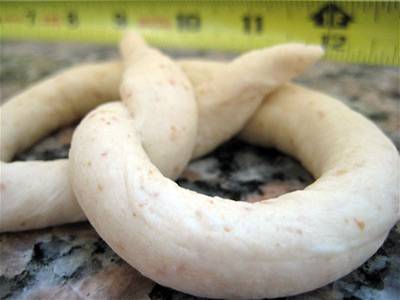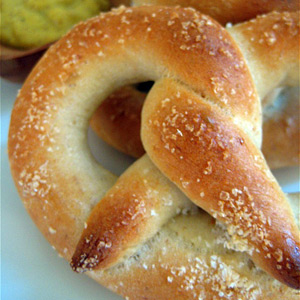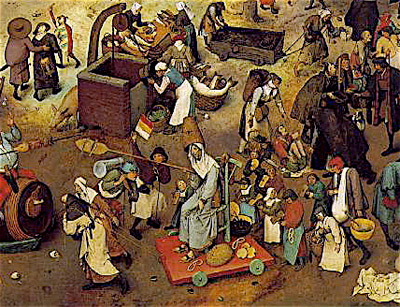Above, Pieter Breugel's "The Fight between Carnival and Lent," 1559. Pretzels were also known as "Lenten Bread." Today, of course, the are synonymous with carnivals.
Pretzels soon came to symbolize good fortune, bringing prosperity and spiritual wholeness with every bite. Wedding couples fell into the practice of breaking a pretzel, much like one might break a wishbone on Thanksgiving-- the person with the larger piece was assured domestic happiness. What the loser was left with, besides a smaller bit of pretzel, is unknown. The pretzel, over time, came to symbolize the tying of the marriage knot.
Most importantly, the pretzel seems to have been directly responsible for the invention of the croissant (at least, according to folklore). During either the Siege of Vienna in 1529 or the Battle of Vienna in 1683 (you can read an interesting commentary on this at JoePastry.com, legend has it that pretzel bakers, working in the pre-dawn hours in their cellar workshops near the city’s walls, heard the clang of the Ottoman invaders' digging tools, warned the Austrian army of the enemy’s tunneling efforts, thus saving the city. In commemoration, the bakers of the city created the kipfel, a crescent-shaped pastry mimicking the crescent moons of the Turkish banners. It wasn’t until France’s favorite Austrian, Marie Antoinette, moved to Versailles with her pastry chefs that the kipfel became more commonly known as the croissant.
You can take all that, more or less, with a grain of kosher salt.
Chewy Pretzels

I received a cookbook (on loan) entitled Breads, Soups, & Salads! by Sharon Baizer Winstein from the person who, in his way, has tied me up in my own, special kind of knot. He met the author years ago in Spokane when she was on her national book-promoting/ visiting-the-grandkids tour. How could I not want to try a recipe from a woman who combines business and pleasure so efficiently?
The recipe is stated to be "fun for kids to do with an adult helper." Well, it is easy. I have a feeling that the level of fun depends upon the attitude of the adult and the age of the children.
Makes: 16 soft, chewy pretzels.
Ingredients:
1 1⁄2 cups minus 2 tablespoons very warm water
1 tablespoon granulated sugar
1 package active dry yeast
2 tablespoons cider vinegar
3 1⁄2 cups unbleached flour
1⁄4 cup toasted wheat germ
3⁄4 teaspoon salt
oil or non-stick spray
kosher salt, for topping
1 egg white, for glaze
Preparation:
Pre-heat oven to 425 ° F. Place oven rack on top shelf.
1. Warm a large (4-quart) mixing bowl with hot tap water. If you have a stand, mixer, your pretzel-making life is going to be much, much easier. Empty and immediately add the warm, measured water and sugar into bowl. Stir to dissolve sugar. Sprinkle yeast over the surface of the water and add vinegar. Let rest (of course, the yeast is really being hyperactive at this point, so I suppose I should just say “let it do its thing”) for 10 minutes. The mixture will foam slightly.
2. Put 3 1⁄4 cups of the flour, 1⁄4 cup toasted wheat germ, and 3⁄4 teaspoon salt in another bowl. Mix well.
3. Measure out 2 1⁄4 cups of the flour mixture; stir into the yeasted water. Knead with the dough hook attachment in your stand mixer, or with a lot of stamina without, until the dough is nice and stretchy. Scrape down side of bowl from time to time. Add the remaining flour mixture in small amounts.
4. With flour on your hands (or the hands of a small child, if you like, it doesn’t matter. Make them do the dirty work, they might thank you for it later), work the dough until it becomes soft and tacky, but manageable.
5. Turn dough out onto work surface. Knead dough by hand for a few minutes, until it is “pleasant but slightly tacky” (which seems very much in accordance with my personal world-view). If the dough is unmanageably sticky, work in a little more flour.
6. Put dough on a flour-free surface and squeeze, pull, and roll dough into a 12-inch log of even thickness. Measure the log; cut in half with a knife or dough scraper. With wide-spread fingers, firmly roll each piece into 12-inch logs with ends as thick as the middle. Cut each log into 8 pieces.
7. Line two baking pans with aluminum foil and coat with oil or non-stick spray, or one pan, if you don’t have two. Set near your place of dough-rolling operation.
8. Work with one piece of dough at a time. Place one piece of dough on your work surface. With your palms and wide-spread fingers, roll each piece into an even 18-inch strand. Cross ends, twist once, and bring twisted ends up to rest on the top of the pretzel. Repeat with the rest.




